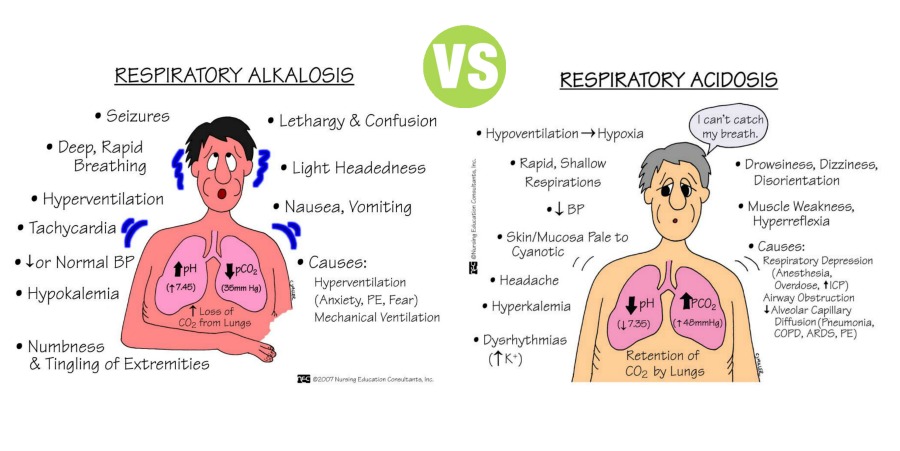Acidosis And Alkalosis : Definition, Types of Imbalances And MCQs for NEET, GPAT, CSIR NET JRF
INTRODUCTION TO ACIDOSIS AND ALKALOSIS :- Normal body pH – 7.4. This level is very important for normal biological activity. This level of pH should be maintained for proper functioning of the body. During normal metabolic activity produces both acid and bases but the acid production is greater then the base production.
TYPES OF IMBALANCES :-
A.] METABOLIC ACIDOSIS :-
1.] A fall in blood pH level due to the metabolic component is brought by the fall of bicarbonate level and excess of H+ ion in the blood. It occurs in the following situation :-
- Increased production of lactic acid which causes lactic acidosis.
- Starvation.
- Uncontrolled diabetes mellitus which causes diabetic ketoacidosis.
- Therapeutic administration of ammonium chloride or acetazolamide (diamox).
- Chronic renal failure.
2.] Due to high blood level of H+ ion in metabolic acidosis this stimulates the respiratory center so that there would be a deep and rapid breathing.
3.] Also, there is a fall in plasma bicarbonates level.
B.] METABOLIC ALKALOSIS :-
1.] A rise in blood pH due to rise in the bicarbonate level of plasma and loss of H+ ion is called metabolic alkalosis. This metabolic alkalosis can be seen in following situations :-
- Due to administration of alkaline salts like sodium bicarbonate.
- Severe and prolonged vomiting.
- Hypokalemia such as in Cushing’s syndrome, increased secretion of aldosterone.

C.] RESPIRATORY ACIDOSIS :-
1.] It is the condition that occurs when the lungs can’t remove enough to the CO2 produced by the body.
2.] Excess of CO2 causes the pH of blood and other bodily fluids to decrease making them too acidic.
3.] This respiratory acidosis can occur in following situations :-
- Impaired neuromuscular function.
- Due to air obstruction which are caused in chronic bronchitis, asthma, emphysema.
- Due to restricted thoracic movement.
4.] Acute respiratory acidosis : Occurs quickly can become life threatening.
5.] Chronic respiratory acidosis : Develop overtime, it doesn’t cause symptoms, instead the body adapts to increased acidity.
D.] RESPIRATORY ALKALOSIS :-
1.] It is the condition which occurs when the level of CO2 and O2 in the blood are not balanced.
2.] Respiratory alkalosis occur when you breathe too fast and too deep and CO2 level drops too low.
3.] This causes the pH of the blood too rise and become too alkaline.
4.] Hyperventilation (over breathing) is the underlying cause of respiratory alkalosis.
5.] Panic attacks and anxiety are the mist common cause of hyperventilation.
6.] Other symptoms include :-
- Dizziness
- Blotting
- Discomfort in the chest area
- Confusions
- Dry mouth
- Felling short of breath

MULTIPLE CHOICE QUESTION [MCQs] :-
1.] Excessive citrate is transfused blood can cause which of the following abnormalities ?
a. Metabolic alkalosis
b. Metabolic acidosis
c. Respiratory alkalosis
d. Respiratory acidosis
2.] Choose the incorrect statement about anion gap out of the following ?
a. In lactic acidosis anion gap is increased
b. Anion gap is decreased in hypercalcemia
c. Anion gap is decreased in lithium toxicity
d. Anion gap is decreased in ketoacidosis
3.] All are true for renal handling of acids in metabolic acidosis except ?
a. Hydrogen ion secretion is increased
b. Bicarbonate reabsorption is decreased
c. Urinary acidity is increased
d. Urinary ammonia is increased
4.] Carbonic anhydrase is present at all places except ?
a. Gastric parietal cells
b. Red blood cells
c. Renal tubular cells
d. Plasma
5.] All are true about metabolic alkalosis except ?
a. Associated with hyperkalemia
b. Associated with decreased ionic calcium concentration
c. Can be caused due to hyperaldosteronium
d. Can be caused due to renin secreting tumor
6.] Which of the following condition will cause respiratory alkalosis ?
a. Fever
b. Anxiety
c. Laryngeal obstruction
d. Salicylate toxicity
7.] Causes of lactic acidosis include all except ?
a. Acute myocardial infraction
b. Hypoxia
c. Circulatory failure
d. Infection
8.] Causes of metabolic alkalosis include all the following except ?
a. Mineralocorticoid deficiency
b. Hypokalemia
c. Thiazide diuretic therapy
d. Recurrent vomiting
9.] In metabolic alkalosis, the blood pH level is ?
a. Increases
b. Decreases
c. Stay the same
d. May increase or decrease
10.] Which of the following is not a cause of metabolic acidosis ?
a. Aspirin toxicity
b. Ileostomy
c. Hyperaldosteronism
d. Carbonic anhydrase inhibitor
SOLUTIONS :-
1.] (a) Metabolic alkalosis
2.] (d) Anion gap is decreased in ketoacidosis
3.] (b) Bicarbonate reabsorption is decreased
4.] (d) Plasma
5.] (a) Associated with hyperkalemia
6.] (c) Laryngeal obstruction
7.] (d) Infection
8.] (a) Mineralocorticoid deficiency
9.] (a) Increases
10.] (c) Hyperaldosteronism
REFERENCES :-
1.] Textbook Of Pathology By Harsh Mohan; 7th edition; Page no. 89.